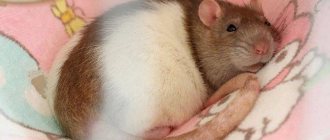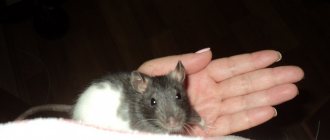Keeping a rat at home
If you have no doubts about your decision to have a rat as a pet, be sure to find out all the features of keeping this type of rodent in your home.
For example, a rat has a very direct relationship with rodents - therefore, walking around the apartment, it will find something to chew on: from shoe laces to equipment wires. In this regard, the animal is either not allowed to go on such walks unattended, or all dangerous or valuable objects are removed in advance.
The second feature of the rat is its smell, which indicates the mark of the territory of residence. Ask yourself, are you ready for fragrant surprises?
Thirdly, rats are afraid of drafts and direct sunlight - you need to remember this when placing your pet’s cage (i.e., a window sill is definitely not a suitable place).
Please note that the comfortable air temperature for a rat is 18-21 °C (despite the fact that the body temperature of a decorative rat is higher than a human one - 38.3-39.3 degrees)
Cell selection
The best home for such a rodent is a large and spacious cage (not a jar, not a container or a box). You can buy it at any pet store - complete with ladders, house, feeder and drinking bowl or separately from them. Some owners make accessories for their pets with their own hands (let us just remember that plywood and cardboard are chewed off quite quickly, and the item will have to be replaced). Of course, the animal will really like and will not get bored with such elements as hanging shelves, a running wheel, swings, and branches that can be climbed. This will be especially appreciated by young individuals, but the “oldies” do not need so much entertainment when decorating the interior of the cage.
When choosing filler for the cage, give preference to large sawdust (small particles of wood species can get into the animal’s eyes, nose or ears and cause an allergic reaction). If you use paper as a bedding, it should be clean, without paint, writing or typography.
Cotton wool is not suitable as a filler!
The cage must be cleaned at least once a week. Be sure to do a complete disinfection to eliminate the risk of infecting your rat with parasites, bacteria and microbes that may appear in a dirty cage.
How to make a walking ball for a hamster with your own hands
There are several ways to make a walking sphere with your own hands.
From an old lampshade
Since the diameter of the lampshades does not exceed 13-15 cm, the product is suitable for Djungarian or young Syrian hamsters. Choose a round transparent or translucent product. Make a round hole in it the size of your pet. Save the cut plastic, it will become a door for the toy. Using a drill, make 5 air holes in the lid.
Throw your hamster inside. During the walk, tape the door so that the rodent cannot leave the toy on its own. The disadvantage is the low quality of the disposable fastener.
From a plastic bottle
Take a 1 liter bottle with a wide neck. For large varieties, you can take a five-liter container. Rinse and dry the bottle. Remove the label so as not to interfere with the animal's exploration of the area outside the toy. Make several long narrow cuts for air access. The more holes there are, the better for the pet. Throw your hamster in through the lid. Be sure to tighten tightly to prevent escape.
Varieties of decorative rats
In principle, there is no such thing as a breed standard among tame rats. Animals are classified according to a large number of characteristics. Many of the formulations are taken from the example of cat and dog varieties.
So, a brief description of the external features:
- color - white, black, Siamese, beige, burmese, agouti, red, brown;
- markings - husky, blaze, Irish, hood, raincoat, mask, cap, Australian;
- ear shape - standard and dumbo (large in the shape of a saucer or tulip);
- eye color - red, ruby, black, two-tone;
- coat type - longhaired, hairless (sphinx), standard, satin, velvet, double rex, downy.
In addition, there are also tailless rats, the so-called “Manx”.
Wiping and drying
There are two potential dangers in bathing a kitty rat. The first is that if water gets into the animal’s ears, the animal runs the risk of becoming seriously ill and even losing hearing. That is why, just in case, both cats and rats are bathed only up to the neck, and the head and face, if necessary, are simply wiped with a wet napkin. The second danger is related to the fact that, unlike a person, a rat, due to the presence of fur on its body, can dry for a very long time, while remaining wet, the frightened animal tries to hide as far as possible and hide from prying eyes.
Also read about how to bathe a chinchilla at home.
Contraindications
Among the factors that are not in favor of swimming, it is worth highlighting two main categories.
Factors that carry a low degree of risk to your pet’s health:
- danger of respiratory diseases in case of improper bathing or drying;
- under-dried fur and hypothermia in water lead to colds;
- water in the ears and eyes leads to diseases of these organs;
- Too frequent bathing and the use of inappropriate detergents cause changes in the protective layer, dry skin and irritation.
Article on the topic: A hamster has died: how to understand and what to do
There are also factors that are more dangerous:
- the presence of scratches and wounds on the body, which steam out if water slowly gets on them, and this leads to itching and inflammation of the skin;
- the presence of a cold or a post-cold condition, at such a moment it is better to do without swimming, otherwise the risk of complications after an illness increases several times, and the recovery procedure is delayed for several weeks.
Thus, we can judge that bathing is a safe and acceptable procedure for rats if it is carried out according to the rules, without overusing the frequency of bathing and using only the necessary means.
In case of any deviations from the norms, it is worth understanding the reasons in detail and solving them, postponing any water procedures for some time. If the pet is completely healthy, tolerates being in water well and is active after bathing, then there is no reason to worry , otherwise, you need to evaluate the need to use water, and sometimes eliminate it altogether, switching to wet wiping with napkins and sponges.
You will learn more about how to bathe a rat at home in the following video.
How to properly bathe a decorative rat at home
There are some things to consider when bathing your rat. So, there is no need to bathe the animal under running water. This is done only in extreme cases, when the rat has gotten dirty in something poisonous.
It is important that water does not get into your ears. Otherwise it threatens with otitis media
A rat's ears fold back, covering the ear canal when it decides to dive. But if you suddenly splash water on the animal, it may not be able to find its bearings.
Dumbo rats should be bathed with extreme caution. Since their ears are lower than other breeds and there is a high risk of water getting in
Bathing a rat is faster and more convenient if you prepare everything in advance. For washing you will need:
- Two basins with warm water;
- Special shampoo for rodents;
- Two towels (paper and fabric);
- A washcloth or soft cloth.
Without skill, it is better not to use brushes or sponges, in order to better clean the fur of a rat, you can injure the animal and cause it pain.
The depth of the water in the basin should be such that the animal can comfortably stand on all four paws, this is no more than 5 centimeters. The water temperature should be 30 -35 degrees. That is, warm. If you don't have a thermometer, check with your elbow.
Attention. During bathing, you need to avoid drafts, as these pets cannot easily tolerate cold air when taking a bath and can get sick.
A complication after a cold in the form of pneumonia leads to the death of the animal in 50% of cases.
The animal should be bathed as follows:
- The rat is placed in a basin and wiped with a wet washcloth or cloth;
- Take the shampoo and gently foam it with your fingertips and apply it to the animal’s fur;
- After this, the rodent is transplanted into a container with clean water and the product is carefully washed off, making sure that the water does not get into the ears;
- Then wipe the animal with a paper towel, and then wrap it in a cloth to dry further.
How to wash a rodent is a difficult question. Ordinary shampoos and soaps cannot be used for a decorative rat, as they contain substances that cause various skin problems in pets.
It is better to buy a special product for bathing rats, or, in extreme cases, for kittens
When choosing a shampoo, it is important that it does not have a strong odor or is completely absent
Some owners use mild baby shampoos for their rodents. This can be done, but you need to carefully study the composition of the product.
Do you use a special shampoo for rodents?
Even clean rats don't particularly care about the cleanliness of their tails.
In the summer heat, this needs to be given due attention. Dirt and dead skin flakes accumulate on the tail
This cleaning is also carried out before exhibitions. Here you can do without taking a bath.
To do this you need to take:
- a bowl of warm water;
- cotton pads - several pieces;
- a toothbrush with soft bristles;
- cream without a strong odor, for example for children;
- shampoo for washing rodents;
- soft cloth or napkin.
First you need to soak away the dirt and dead skin flakes by adding a few drops of shampoo to the basin. If the tail is not very dirty, then you can simply wash it with water.
Cleaning is carried out as follows:
- Apply soapy water to the tail with a cotton pad.
- Start cleaning from the base without pressure, using a soft brush.
- After this, you need to rinse the tail with clean water.
- Then moisturize it with cream.
Attention. If the rat did not want to carry out the procedure to the end or the dirt could not be removed the first time, then repeat the washing after a while
If you want to accustom your rodent to water, then this can be done. The best option would be a game. Of course, during it you need to look after the animal.
Take a shallow dish, such as a saucer, and pour some water into it. Let the rat explore new things, even if it gets into the water. You can also wipe the animal with a sponge. After the game, be sure to treat your pet with a treat.
An animal not accustomed to water will be afraid not so much of the liquid itself, but of the new environment or the noise of the pressure. Therefore, experienced lovers of decorative rats recommend training the animal in advance.
To prevent your pet from experiencing extreme stress when bathing, simply clean the fur with a soft, damp cloth or cotton pad. It is better not to use shampoo, as it will be difficult to wash off.
General rules
It is necessary to wash a rat at home correctly; its well-being depends on this. Before embarking on water procedures, it is worth studying the specific situations in which these measures are necessary:
- getting dirty with waste that was not removed from the cage in time;
- the appearance of any parasites on the animal’s skin or fur;
- if the pet is not eager to take care of its fur on its own;
- a few days before the exhibition.
To make the bathing process safe, you should be fully prepared for the procedure. You need to have a container with you that will be suitable for bathing, shampoo for rats or rodents and towels for drying. You should not use laundry or ordinary soap, regular or baby shampoos, since the composition there is much more aggressive than in specialized products.
If only the rat's tail is dirty, then you should not bathe it completely; it will be enough to wipe only the tail part using a damp sponge and baby cream. When planning water procedures for your pet, you should know that you cannot expose it to running water, since contact with the aquatic environment will be unexpected and extremely unpleasant for the pet, which will provoke stress and fear of such procedures.
Another danger of such bathing will be moisture getting into the ears, which the pet simply will not have time to fold properly to protect itself, as happens in nature.
Article on the topic: Harness and leash for rats: application, purpose, manufacture
Bath
To prevent the bathing procedure from causing panic and fear in your pet rat, it is necessary to gradually accustom it to the procedure. First of all, you should choose the right bath in which your pet will bathe. Its depth and width should be such that the rat feels confident and can get out of the container if such a desire arises. To prevent bathing from causing fear, it is initially better to accustom your pet to the bath by lowering it there for a few minutes, and when the animal gets used to it, you can gradually add water to it.
It is important not to pour a lot of water into the bath; the rat should be on its paws while bathing and calmly move around the container in any direction. If you add all the water at once, there is a risk of frightening the pet, in which it will begin to scratch and can injure both itself and its owner.
With the optimal amount of water, there is no significant risk that it will get into the eyes and ears of the animal and harm it. If the bath is overcrowded, then the possibility of incorrectly bathing the rat increases significantly.
Water temperature
In addition to the correct amount of water, you also need to monitor its temperature. This is important both for the animal’s comfort during bathing and for its subsequent health. If the parameters are incorrectly selected, the rat may become stressed during the procedure and become ill after its completion. The optimal temperature for swimming will be within 36-37 degrees.
You should not prepare two containers to bathe your pet, because the water in them will have different temperatures, which will negatively affect the condition of the animal. To avoid foaming the bath water too much, it is better to use a small amount of shampoo while lathering, so that it can be quickly and effectively rinsed off.
It is not necessary to wash a rat's face, because they themselves constantly wipe it throughout the day. By choosing the right container, accustoming the animal to it and setting the temperature correctly, you can bathe the rodent efficiently and provide it with appropriate care. Girl rats can be bathed once a month. Male rats should be subjected to this process twice or given additional wipes weekly using hypoallergenic wet wipes.
Accessories and tools
The right bath and the right water temperature are very important criteria for the bathing procedure, but accessories and means for it are also of significant importance. The rodent's body is covered with thin skin, which can be easily injured if too much force is applied. In addition, like many other similar animals, the skin has a protective layer that helps in a variety of situations and maintains normal health for the rat. If you use the wrong shampoos and washcloths, there is a risk of damaging the protective layer, and in the worst case, the skin itself.
Article on the topic: Names for rats, girls and boys: how to name a rodent (help in choosing a nickname)
It is best to bathe your rat using a small, very soft washcloth and brush. With their help, it is possible to reach all hard-to-reach places and wash them thoroughly. As for the products, you should use exclusively specialized shampoo for rodents, which is designed taking into account all the characteristics of the fur of these animals and their skin.
If you use soap or another product, you can disrupt the normal condition of the skin, which will cause irritation, itching, and affect the fur.
Bathing
To carry out the bathing procedure correctly, you must have with you:
All components are prepared in advance and tested for suitability and convenience for the rodent. If possible, you should check the water with a thermometer or dip your elbow into it. The optimal mode will be 30-35 degrees on the thermometer or the feeling of warm water, if you independently determine its temperature. About 5 cm of water is poured into the bath, and then the rat is placed there.
The bathing procedure is as follows:
- the pet’s fur must be carefully moistened, making sure that the face and ears remain dry;
- foam the shampoo on a washcloth or using your fingers, and carefully apply it to the fur, gently massaging it;
- Using a washcloth, carefully rinse off the shampoo with water from the bath.
After bathing, be sure to dry the rodent until the fur is completely dry. If a rat is afraid of water, then you should not force bathe it, this will only increase its fear. It is important to carry out preparatory measures that will allow the animal to get used to the aquatic environment and be calm in it. The owner should pour a little water into a saucer or other spacious low container so that the animal can run freely in such conditions.
After playing, it is very important to treat the rat with his favorite treat, which should also be given at first after each bath.
Drying
The drying process is no less important than the bathing itself, because the pet’s health depends on it. If you don't dry your rat's fur or dry it poorly, it may catch a cold. When planning water treatments, it is important to check the room for drafts and, if possible, eliminate them in order to protect the animal. When preparing for a swim, you should have at least two paper towels and one soft cloth towel with you.
Article on the topic: Cage for rats: rules for selection and arrangement (photo)
With the help of paper products, it is possible to quickly remove the bulk of the water that remains on the wool after bathing. Once the excess has been removed, you need to wrap the animal in a cloth towel and keep it there until it is completely dry. There is no need to rub the fur; this will be unpleasant for the rodent and can harm its skin or protective covering.
To ensure that your pet sits quietly after bathing and does not struggle, you should treat him with something tasty and talk in a soft voice, calming him down. Having endured several such procedures, the rat gradually gets used to it and is more peaceful about such care, which significantly speeds up and makes the task easier for the owner.
What to do if the animal is afraid, bites and breaks out
By its nature, the decorative rat is completely non-aggressive. Although there are some exceptions. But, nevertheless, in many cases, bites are not a manifestation of anger, but a defensive reaction. Therefore, you need to understand the question of why the animal began to bite.
If the little rat had not bitten before, and then began to do so, then most likely your behavior or that of your family members has shaken his trust. Remember if you have pushed, pinched or stepped on an animal recently. Such actions, like physical punishment, can cause not only a desire to bite, but also fear. In addition, a tamed animal can escape from one’s hands, although there were no problems before. Physical pain for a pet is a threat to it, so this behavior is a defensive reaction of the rat.
Bites can mean many things:
- interest - the animal gently nibbles with its teeth;
- thirst for affection - bites as if biting off the fur of a relative;
- showing superiority - trying to show with a bite who is in charge in the family;
- attracting attention - a sudden bite from an unexpectedly visiting pet;
- playful mood - bites, runs away and comes back;
- warning - a response to your actions, as an option it hurts him;
- fright - after a bite the pet runs, breathes heavily, wants to hide.
During puberty (at 5–7 months of life), males may begin to bite, hiss and snort. This is hormonal maturation, growing up and defending territory. Females mainly bite when they are pregnant or caring for pups.
Also find out how to teach a rat to go to the toilet in a litter tray.
To prevent your pet from becoming aggressive, you need to:
- provide the rat with peace during the adaptation period;
- do not insert food or fingers between the cage bars, only through the door;
- play with the animal every day;
- reduce the noise level around your pet;
- Do not hit the rat under any circumstances.
Any attempts to bite must be stopped. If a rat bites, drive it away from you. She will quickly understand that this cannot be done. If a rat bites you, you must squeeze out the blood from the wound to prevent inflammation, treat it with peroxide and an antiseptic. You can visit the hospital if you wish. The main thing is that the animal is vaccinated.
Do rats like bathing?
Few pets like water treatments; most rodents are cool towards them. A healthy individual is able to maintain hygiene at a sufficient level, so they do not need bathing. In rare cases, animals really like to splash; in general, they rather tolerate this procedure.
If pets love to swim, you should be careful about the correct identification of your pet. The fact is that the closest relative of rats, the pasyuk, feels great on the water. Outwardly it is difficult to distinguish them, but the latter has a wild disposition. But even they prefer dry methods for hygiene reasons - in their natural environment, water is a hunting ground for them.
Breeds of rats
Sphynx rat
Curly rat
Tailless rat
Female or male?
Implicit external differences between rats of different sexes nevertheless give rise to obvious differences in behavior.
Males are suitable for an owner who is going to take his little friend with him everywhere, since male rats become more attached and are calmer. True, their disadvantage is uncleanliness or, more simply, a natural need to mark territory.
Females, as in the human world, look after themselves and the surrounding territory, but will not sit on your shoulder or in your pocket, preferring freedom of action.
Place of purchase.
You must buy an animal from a trusted place with a good reputation and all the documents and certificates for the animal. Here it is better to play it safe than to bring an unknown infection into your apartment.
How to choose a healthy animal.
A healthy baby rat is inquisitive - this is its main quality and the criterion by which you should choose an animal in a store. The animal, which became interested in the hand brought to the cage, calmly came up to sniff and communicate, demonstrating the most natural behavior for a healthy individual. Lethargic, half-asleep animals or, on the contrary, overly excited animals should not inspire confidence in buyers. When purchased, the rat should be between a month and a half old - not too young to have already acquired all the skills necessary for life from its mother, but not too old to quickly get used to its new owner.
When you first examine a rat in a store, there should be nothing alarming. Namely, it should not be:
- damage to the paws, tail or other parts of the body;
- inflammation, bald spots or parasites on the skin and coat;
- discharge from the eyes, nose or ears;
- dirt on the anus (this would mean diarrhea, which is difficult to cure in rats);
- sneezing or uneven breathing, indicating a cold.
If, when purchasing, there is at least something alarming about the appearance of the rat, you should not buy it, especially out of pity, since the consequences of such a choice can be the most disastrous.
Is it possible to bathe pet rats?
First of all, it should be noted that the rat, no matter how strange it may sound, is a very clean animal. If you care for such an animal correctly, make sure that the bedding in the cage is always dry and fresh; water treatments as such are absolutely not necessary for the decorative rodent. Moreover, water, especially in combination with various detergents, washes away the natural protective fat layer from the skin of a pet, which does not have a very good effect on the condition of the coat, and sometimes can even cause the development of various dermatological diseases.
Important! Bathing for a decorative pet rat is not a prerequisite for normal keeping, but rather an exception to the rule. It is necessary to wash the animal only when it is objectively necessary for one reason or another. It is interesting that in such situations the owner, not understanding the true cause of the problem, tries to bathe the animal even more often, which only aggravates the pathological processes
As a general rule, it is advisable to carefully wash a decorative rat only if the animal managed to get into something it shouldn’t and got really dirty. And the unpleasant odor that a pet sometimes acquires must be combated not by bathing, but by observing basic hygienic requirements for the rodent’s home. The main thing is that you should never leave uneaten wet food in the cage. In the process of rotting, such organic matter not only begins to smell disgusting, but also becomes a source of dangerous infections, which can then create problems for both the pet and its owner. The source of the smell can also be poor bedding in the cage. So, similar problems arise if you use sand, cut paper or sawdust for this purpose. A good solution could be pressed cat litter - it absorbs liquid and absorbs strong odors.
In addition, you need to understand that if the unpleasant smell of an animal is associated with a violation of the conditions of its detention (and this is what usually happens), after bathing the problem will only worsen - wet fur stinks even more. Having dried, the animal initially smells like shampoo, but this introduced aroma very quickly dissipates, and the situation returns to its original position. In veterinary medicine, there are no strict rules regarding the age at which pet rats should begin to be bathed, and this is absolutely understandable.
Did you know? Waterfowl rodents are found in nature: in addition to the well-known beaver, they also include nutria, muskrats (musk rats), water rats, as well as the exotic animal pacarana. However, ornamental rats are a domesticated species of the gray rat (Rattus norvegicus), and its natural habitat is in no way connected with water or swimming.
Unique Fertility
In the Russian Federation the following types are most often found:
- Gray or pasyuk;
- Black;
- Turkestan (red).
One can only wonder why nature awarded rats with such amazingly productive fertility. They live and breed all over the world, not paying attention to either cold or hot climates, and their activity lasts all round. And only unforeseen natural disasters or any mass diseases can temporarily reduce their numbers.
Scientists believe that it was humans who contributed to changes in the behavior and survival of rats. Living next to a person, eating the products that he produces, these rodents live freely and comfortably. After all, food is always available, and all the traps prepared by people can be avoided. And if one rat was poisoned, the others will no longer approach such food. These animals have a fairly high intelligence. It is assumed that they have the makings of abstract thinking, which helps them navigate and stay alive in an unfamiliar place. All these skills are adopted by subsequent generations.
And considering how rats reproduce, all that remains is to start fighting them in time, because their activity in this case can take on catastrophic proportions.
Preparing for a swim
Keeping decorative rodents necessarily includes washing, to prepare for which the owner will need:
- study your pet's behavior;
- choose a special shampoo and place for the procedure.
Before washing a rat at home, you should study its reaction to water. Some individuals willingly take a bath and even swim, while others avoid even wet surfaces in every possible way. The presence of a bath in the cage and interest in it are clear indicators.
To avoid stress and prepare your pet, try wetting him slightly, avoiding getting any moisture in the ears, nose, or eyes. If the rodent reacted calmly, then you can bathe it without any problems. If fear manifests itself, the procedure should be carried out in a small container or sink
It is important that the pet stands firmly on its paws, so you should lay a small towel on the bottom
It is better to purchase detergents in specialized stores. Shampoos for rodents do not disturb the natural fat film, allow you to fight parasites and carefully care for the fur.
Do rats like to swim?
Pasyuki are excellent swimmers, and they can last in the water for about three days. The wild counterparts of ornamental rats are excellent divers and even hunt underwater. But even in this situation, they do not use reservoirs for the purpose of personal hygiene. To keep their fur clean, they use sand or their own teeth. Thus, they will not use water unless absolutely necessary. Undoubtedly, you can meet a rodent who simply loves to swim, but there are much fewer of them than those who do not like water and try to escape from it.
Is it possible to bathe pet rats?
Anyone who has a decorative rat as a pet sooner or later worries about the question of whether it can be bathed. On rat breeder forums, bathing is one of the popular and rather controversial topics. There are supporters who categorically claim that this is unacceptable and dangerous, and there are those who consider this a necessary procedure for the health of the pet. Experts believe that water procedures are acceptable if they are carried out infrequently and in compliance with all safety measures.
Also, do not forget that during water procedures a rat can escape, thereby causing damage to itself and the person who bathes it. Also, water can get into the animal’s ears, which, in turn, will cause deafness.
So you need to bathe a rat only if there are real reasons for it.
When do rats need water treatments?
There is no particular need to bathe a decorative rat, but there are exceptions:
- if the rodent gets dirty in a harmful substance;
- if the animal was in a dirty cage for a long time;
- in cases where the animal does not clean its coat on its own (the animal is sick or simply unkempt);
- when parasites are removed;
- a couple of days before the exhibition.
Some animals enjoy bathing procedures, they can be bathed more often, but still, even if you love water, you should not abuse water procedures.
If your pet does not like water at all, you should not bathe it unless absolutely necessary to avoid psychological trauma and deterioration of health. If the contamination is not severe, it is better to stop using shampoo and wash the animal with just water. Try to talk to your pet to support him and remove the feeling of fear.
If a rodent has a cold, it is better to avoid water procedures so as not to aggravate the situation.
Rats love cleanliness and try not to shit where they eat and rest, therefore, by installing a special toilet, you can get rid of unpleasant odors, and as a result, the need for unnecessary water procedures.
Productive offspring all year round
Rats' minks are always clean and well-groomed. Having found shelter, they make additional passages and then deftly navigate through them. They find refuge for themselves:
- Digging a hole yourself;
- Having captured a hole already made by another small animal;
- By occupying a nest made by a bird or animal;
- Using any convenient building structures.
They live not only in families, there are also loners. Rats united in colonies pose a particular danger to people, since this form of organization can exceed the number of more than 1000 individuals. Of course, they also need a very large territory. In addition, they guard it very actively. Colonies are found primarily in large cities. Sometimes their number is equal to the population!
If you study the birth statistics of rats, you may get the impression that they are only busy reproducing. With the exception of northern populations, these animals reproduce throughout the year, but the number of pups born varies for each individual. For example, if this:
- The gray rat, on average, can give birth to up to 9 cubs in one litter, but sometimes their number reaches 20;
- The Australian species is distinguished by a smaller number of births - from 3 to 15;
- The Malayan species produces from 3 to 6 cubs in one litter.
However, rats also have enemies who happily eat them, helping people reduce the spread of dangerous rodents.
Where do parasites come from in decorative rats? Precautionary measures
training rats - perhaps at the right time, thanks to training, the rat will not eat what it does not need.
How and where do they come from? Most often - from the filler that you use in the cage (we are talking about natural fillers - hay and sawdust). Inexperienced owners, in order to save money, purchase them not in special stores, but at sawmills. The result is infection of animals, since such material is not disinfected in any way. It is also easy to bring dangerous animals on your own body from the street. So the main ways to prevent misfortune are to use a safe litter and wash your hands thoroughly before each contact with the animal.
What should a rat cage look like?
The optimal home for a rat would be a cage made of metal rods with a tray. Rats can climb on the grates, they are well ventilated and allow you to observe what is happening around. The distance between the rods should be about 1.5-1.7 cm (or less). If the bars are too thin (2 cm or more), the baby rats will try to crawl between the bars. At best, the pet will simply run away, and at worst, it will get stuck and suffer.
Excuse me, do you have anything tasty for the poor little rat?
In addition to size, the configuration of the cell is important. A flat (low) cage is not an option. No matter how big it is, the animals will be bored in it. Guinea pigs or hamsters live in fields, and the rat world is more complex and varied. The cage should have several levels.
A real palace for rats
It is better if the metal rods are painted. Then they will not oxidize from the caustic urine of animals, and there will be no stains on them.
“I’m sitting behind bars in a damp dungeon.” Painted rods are the best option for rats.
There are two types of cage trays: with and without a false bottom. The false bottom is designed like this: the animals run along the grate, the tray is located below. The mesh should be fine enough so that the rats do not fall through with their paws. But not too much - so that feces fall through.
Overall, using a plastic false bottom seems like a great idea to me. It can be partially covered to make the rats more comfortable, additionally put paper towels in the cage for the house and hang hammocks for sleeping.
The shelves are lined with soft fleece fabric: it is soft, dries quickly, and does not tangle your paws
Factors affecting reproduction
Despite the fact that rats breed a lot and often, there are a number of factors that have a serious impact on the reproductive functions of the rodent body.
Environment
The environment plays a huge role in the life of any living creature. A person is able to cope with this by building warm homes, creating clothes and other things to protect himself from the influence of the environment. Rats can't do that, so they've learned to adapt.
These rodents adapt perfectly to any climate, but the climate itself changes the rodents so that they do not die. So, if the population happens to live in frosty areas, the number of cubs that the female will give birth to will sharply decrease. The quality of the offspring will also suffer, as many pups will be stillborn.
Nutrition
Poor nutrition affects adult rats. Pet rodents always have access to healthy and tasty food, so they are full of energy and always healthy. Wild rats eat what they find under their feet, and this is not always food that is healthy for their body. Quite often, a rat can eat some kind of poison, but not die and suffer poisoning, but serious harm will already be done to its body . Read more about rat poisons in this article.
Living conditions
A hostile environment is often the main factor that disrupts the reproduction process. In a stressful state, when there are either traps set up or predators everywhere, female rats have a hard time with pregnancy, miscarriages often occur and dead rat pups are born. Just as mentioned above, due to the constant danger, rats may eat live young ones to protect them from predators. By carrying live rat pups from place to place, the female often exposes them to danger. Naked babies simply freeze while their mother carries them in her teeth.
Ecology
Chemical emissions into the atmosphere, radiation, and contaminated soil also have a detrimental effect on the health of rats. If poisoning can affect several individuals, then constant presence in the contaminated area affects the entire population. Childbirth is difficult, pregnancy is also difficult, mutations and the absence of the reproductive system in general are observed. The population begins to degenerate.
Sources:
https://zagorod-live.ru/borba-s-vreditelyami/myshi-i-krysy/kak-razmnozhayutsya-krysy.html https://homkin.ru/krysy/zdorovie-krys/razvedenie-i-sparivanie-krys .html https://xn—-gtbdaj1bvbjgo3a0g.xn--p1ai/unichtozhenie-gryzunov/krysy/kak-razmnozhayutsya/











